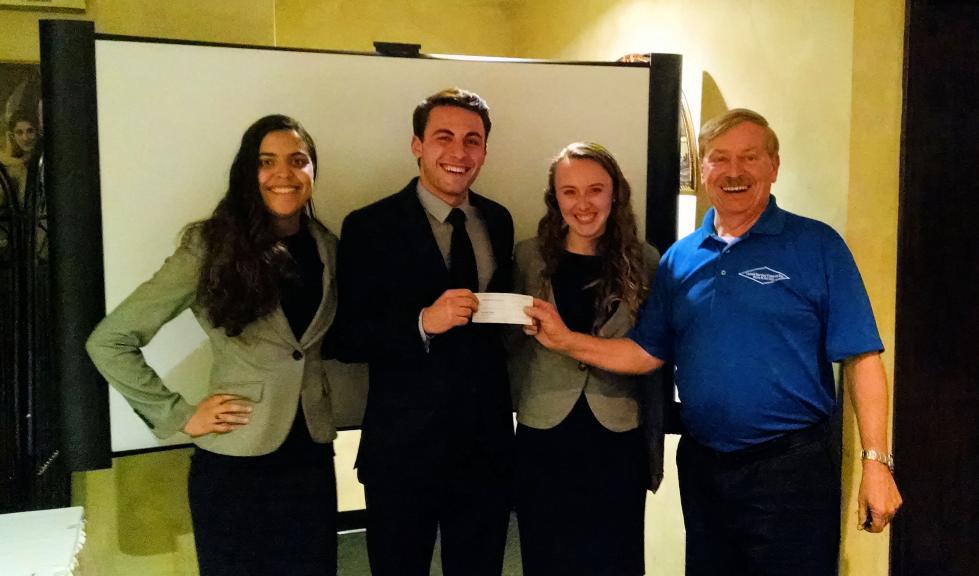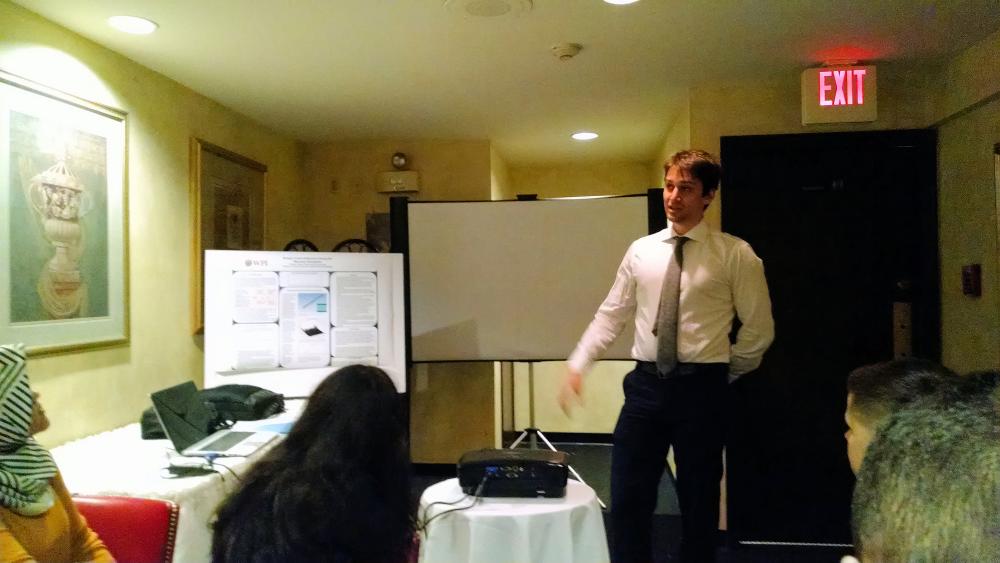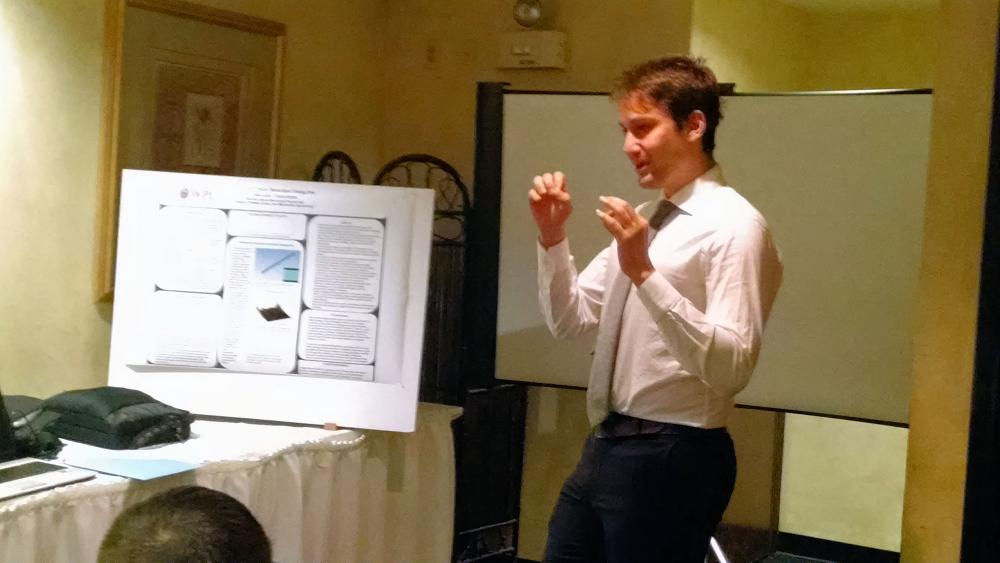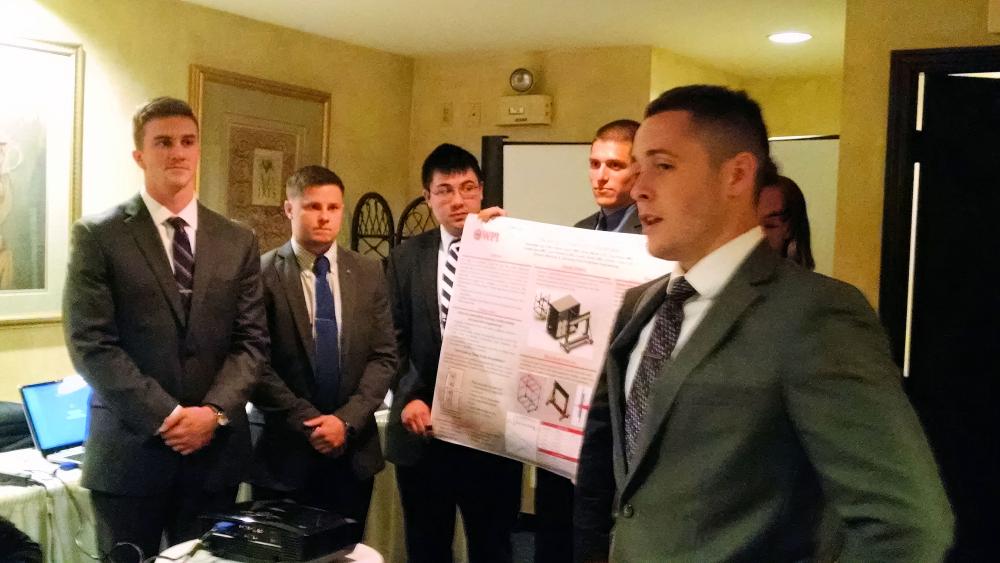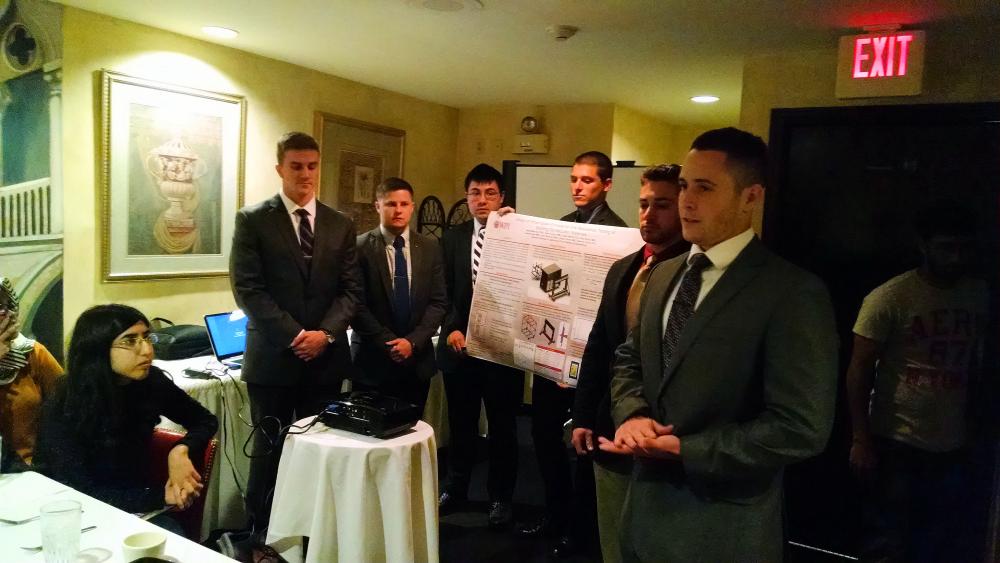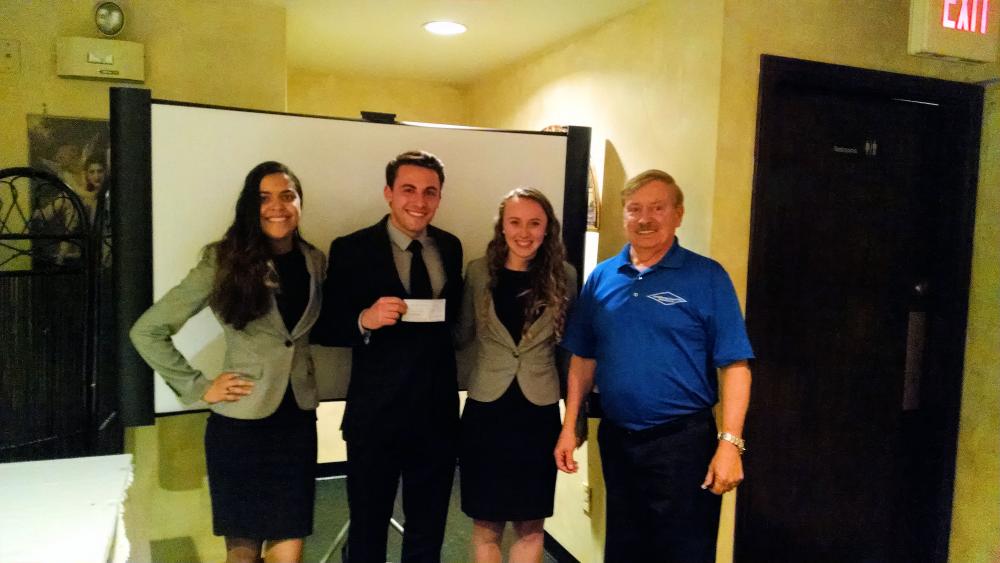Department(s):
Materials Science & EngineeringThis year, Project Presentation Day was held on April 20, 2017. Seniors from all departments presented their Major Qualifying Projects (MQP). The department of Mechanical Engineering had presentations from six different categories: Biomechanical, Design, Manufacturing, Materials, Robotics and Thermo fluids. The Materials category had 7 MQPs under it and the advisors were Diran Apelian, Nicholas Dembsey,Zhikun Hou, Diana Lados & Germano Iannacchione, Brajendra Mishra, Amy Peterson, Pratap Rao and Cagdas Onal.
The following students' presentations were chosen to present at the ASM dinner to present their posters as they compete for a cash prize:
- Joseph Igoe, Alexander Ing, Kevin Lynch, Dylan Martel, Lynn Renner, Tara Sharp, Austin Smith, Steven Thulin
- Theofilos Gatsos
- Daniel Braconnier, kristin Markuson, Mila Maynard
The winning group was the 'Fabrication and Properties of Novel Polymer-Metal Composites Using 3D Printing' by Braconnier, Markuson and Maynard. COngratulations!
Below are the titles, advisors and students who presented their MQPs under the Materials Science & Engineering Umbrella on project presentation day.
Development of an Experimental Optimization method in Laser-Assisted Cold Spray
By Sean Hathaway, Mikhail Khibkin and Matthew Nicholson
Advisor: Diran Apelian
Current experimental optimization methods take extended periods of time and do not have a systematic way to get closer to the optimum. As a result, the team set out to generate a new, systematic approach to experimental optimization that costs time and cost. First, a theoretical goodness equation was used to predict the influential trends of parameters in the Laser-Assisted Cold Spray (LACS) process on three material properties. This was also used to select the algorithm used, Mine Blast Algorithm. The equation and algorithm was then modified for the experimental process which included a fourth variable. The team was able to achieve a goodness of 0.66 after only 5 iterations of the estimated 25 iterations necessary to achieve optimization (30 samples).
Design of Small-scale Furnace for Fire Resistance Testing of Building Construction Materials
By Joseph Igoe, Alexander Ing, Kevin Lynch, Dylan Martel, Lynn Renner, Tara Sharp, Austin Smith, Steven Thulin
Advisor: Nicholas Dembsey
Fire resistance testing is a critical tool that contributes to meeting the fire and life safety objectives prescribed by model building codes. For many types of building construction, these prescriptive codes employ structural fire engineering to promote the strategic placement of fire rated walls, partitions, and floor or roof assemblies. The ratings of these assemblies are determined by fire resistant test procedures, including ASTM E119, Fire Tests of Building Construction and Materials. Specific ratings are measured by an assembly’s time to failure under a standardized fire exposure. Full-scale E119 furnace testing is expensive and not well suited to assembly optimization. The goal of this project was to build a small-scale furnace apparatus capable of performing economical fire resistance tests. Analyses supporting the design, manufacture and operation of a small-scale furnace test apparatus were conducted to establish correspondence between the small-scale furnace and the full-scale E119 furnace.
Crack Detection Using The Wavelets Transform
By Theofilos Gatsos
Advisor: Zhikun Hou
This report develops an algorithm for the detection of cracks on bridge structures, based on the Wavelet Transform (WT). A review of the state of the art techniques for crack detection of beams and bridges is made, and numerical parametric studies for Finite Element Modeling and WT characteristics, such as wavelet type and noise effects, are performed. The results from these attempts are used for the development of a robust approach to detecting damage in bridge structures, introducing the concept of multiple-support-bridge crack detection. Both direct use of mode shapes and of moving load approaches to detection are made, commenting on the advantages and drawbacks of each. An overall assessment of the state of the art of WT damage detection is given in the concluding paragraphs.
Thermal and Electrical Trasnport Measurements in Casr and Wrought Aluminum Alloys
By Gyneth Campbell, Scott Davidson, Adam Gatehouse, Daniel Mortarelli
Advisors: Diana Lados, Germano Iannacchione(PH)
The goals of this project were to build an apparatus for the automated measurement of thermal and electrical conductivities of metals, while developing an integrated methodology to further relate these physical properties to the materials' characteristic microstructures. Aluminum systems were selected for the study, which included both wrought (6061, 7075, 2024) and cast (A356, 319, A390) alloys. The microstructures of the materials were altered via chemistry and thermal modification (heat treatment) in order to systematically study the effects of grain size, secondary dendrite arm spacing (SDAS), and morphology of secondary phases (eutectic Si particles). A DC method was employed for the thermal and electrical (4-wire) conductivity measurements. The microstructures of the alloys were quantitatively characterized using an optical microscope with image analysis. Micro-hardness evaluations of the aluminum matrix before and after heat treatment were also performed. Novel relationships between the alloys conductivities and their characteristic microstructural features were uniquely established.
Assessing Carbon Footprint
By Richard Coffin, Matthew Puksta, Muhammad Siddiq, Antonio Tachiaos
Advisor: Brajendra Mishra
This project was focused on the automotive recycling industry in Massachusetts. the study was sponsored by the Automotive Recyclers of Massachusetts(ARM). The goals of this study were to understand how much material is recovered, reused, and recycled and how these activities impact the state's carbon footprint. The report includes the understanding f how environmental hazards, such as waste oil, are processed, the type and volume of parts recovered and the amount of hazardous materials that are safely processed. The difference in carbon footprint between processing recycled materials and using primary raw materials have been analyzed . A survey of the members of ARM was conducted. the primary method of data analysis id through the use of 'Sustainable Minds' - a software program used to calculate the carbon footprint of the process involved. The study has determined that for this specific Industry, the carbon footprint is significantly negative, however it is recommended that this study be furthered to include processes, such as shredding, smelting and casting.
Fabrication and Properties of Novel Polymer-Metal Composites using 3-D Printing
By Daniel Braconnier, kristin Markuson, Mila Maynard
Advisors: Amy Peterson (CHE), Diana Lados, Germano Iannacchione(PH)
This project investigated the novel fabrication and properties of polymer-metal composites (PMCs) using 3D printing (fused deposition modeling–FDM). Mechanical and physical properties of acrylonitrile butadiene styrene (ABS)–stainless steel PMCs (with 5,10,15, and 23 wt.% stainless steel powder additions) were generated and compared with those of the base ABS. Tensile testing, dynamic mechanical analysis, differential scanning calorimetry, optical microscopy, and scanning electron microscopy were employed to characterize all materials/conditions. A new methodology to fabricate the composites was first developed. The resulting materials were then extruded into PMC filaments, which were further used to print tensile specimens. Controlling printing parameters, deposition layout and orientation were systematically investigated in order to optimize the process (minimize porosity and enhance homogeneity and interlayer bonding) and improve materials' properties. The results demonstrate feasibility of using 3D printing to create PMCs with increased functionality (magnetic and conductive properties), while preserving or enhancing their mechanical properties.
Flexible Solar Cell
By Francis LaRovere, Michael McMahon, Edward Peglow
Advisors: Pratap Rao, Cadgas Onal
Solar energy can be made more widely accessible by creating versatile solar cells that can be implemented in novel applications. Making solar cells mechanically flexible greatly increases their versatility. Current materials being used for flexible solar cells are unstable, expensive, inefficient, or toxic. The goal of our project was to synthesize flexible absorber, buffer, and blocking layers out of earth-abundant, non-toxic materials to achieve solar cells that are both flexible and efficient. We chose antimony sulfide (Sb2S3), copper (I) thiocyanate (CuSCN) and titanium dioxide (TiO2) for these respective layers on the basis of efficiency, mechanical flexibility, cost, stability and safety. We explored low-temperature synthesis methods to realize this flexible design on a plastic substrate, and evaluated the design by observing the microstructural changes that occurred due to bending.
